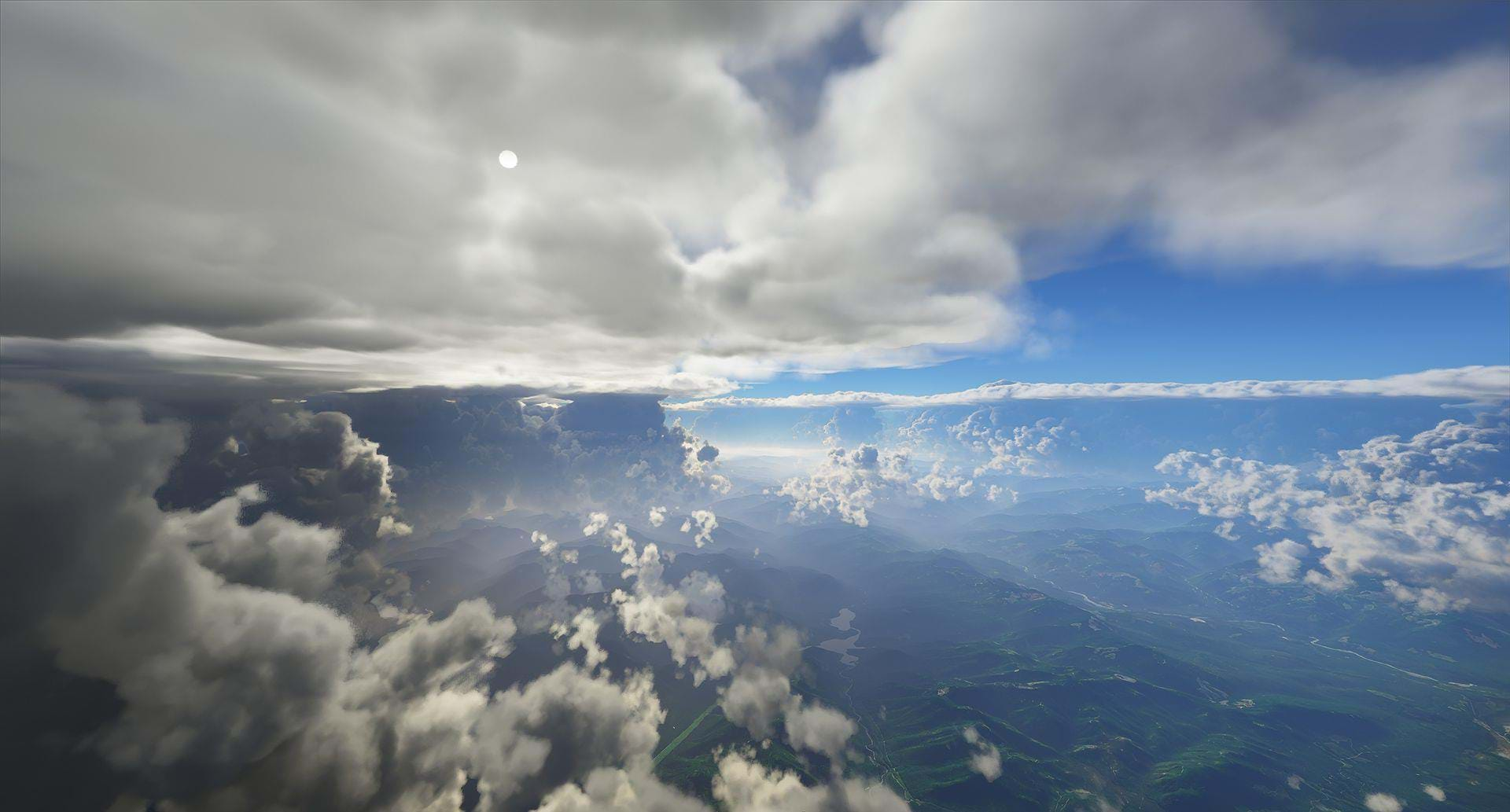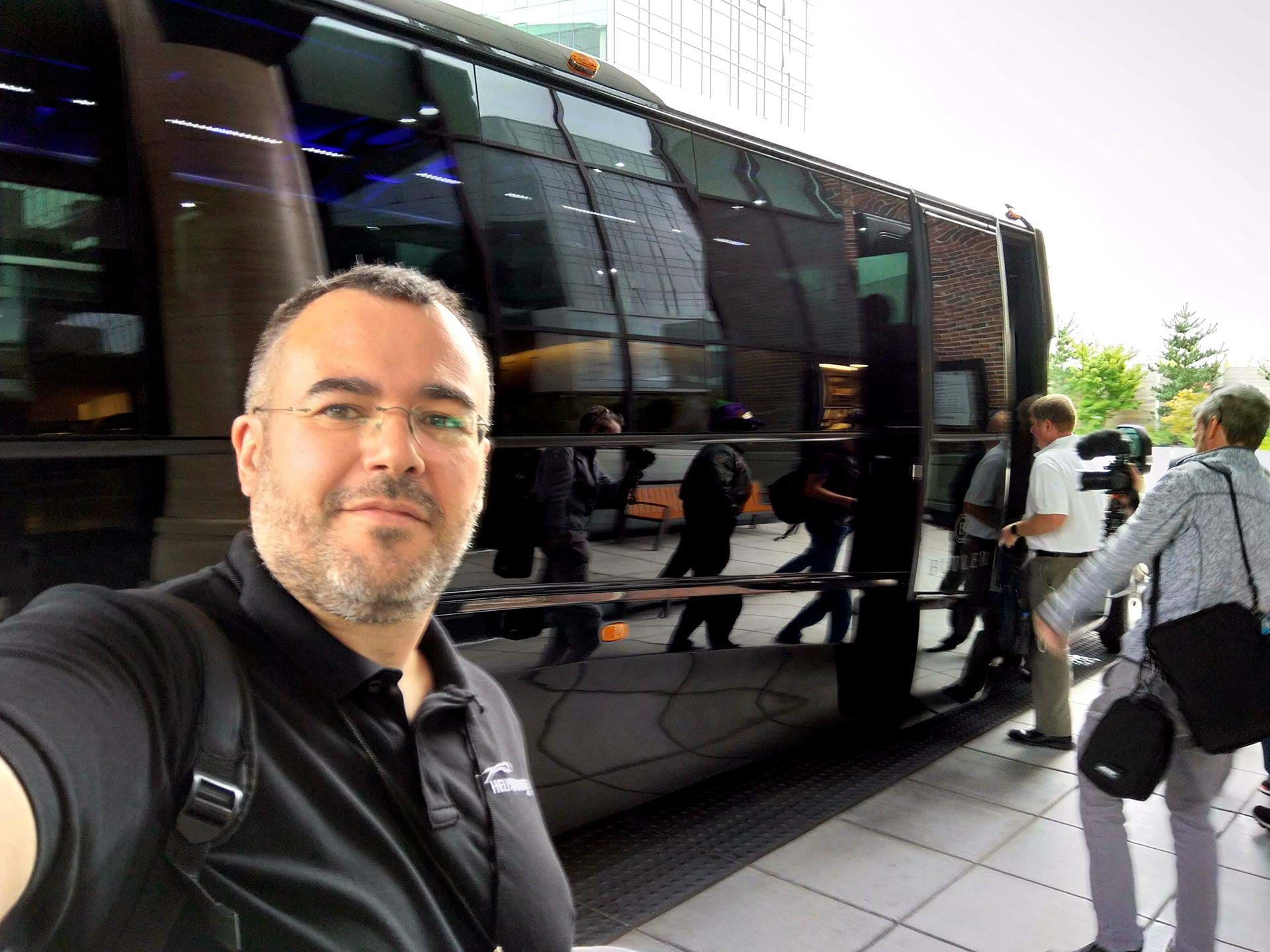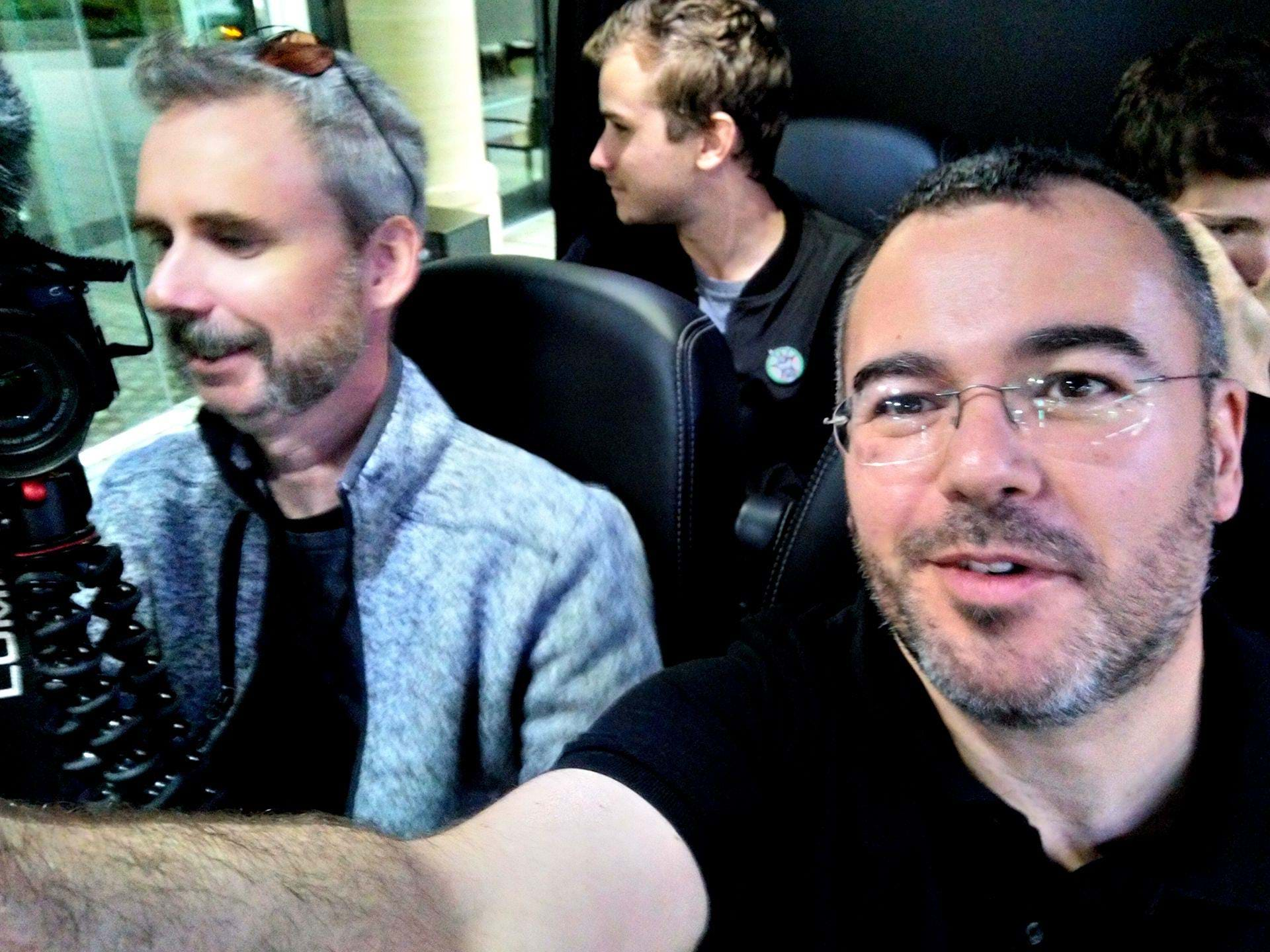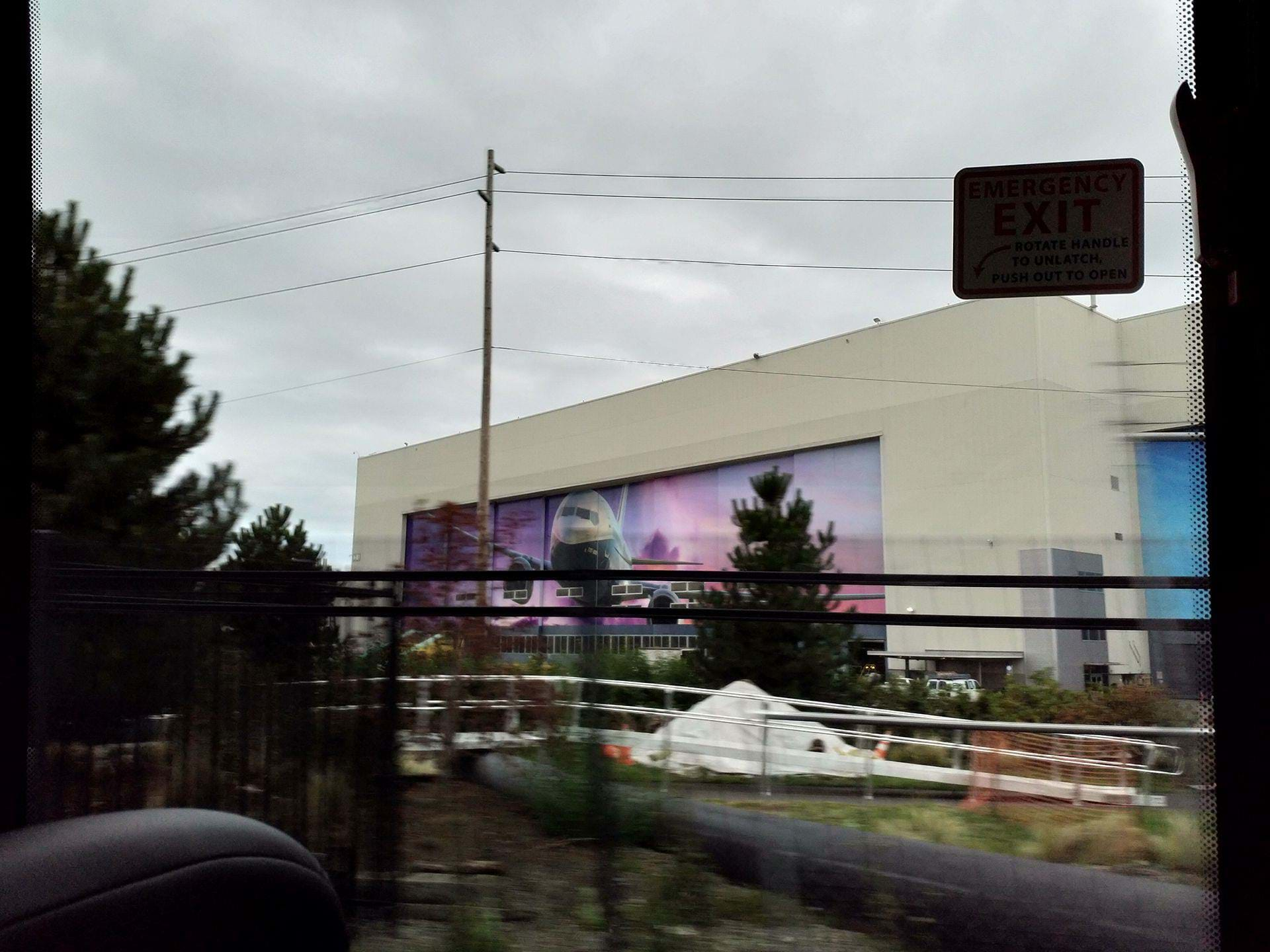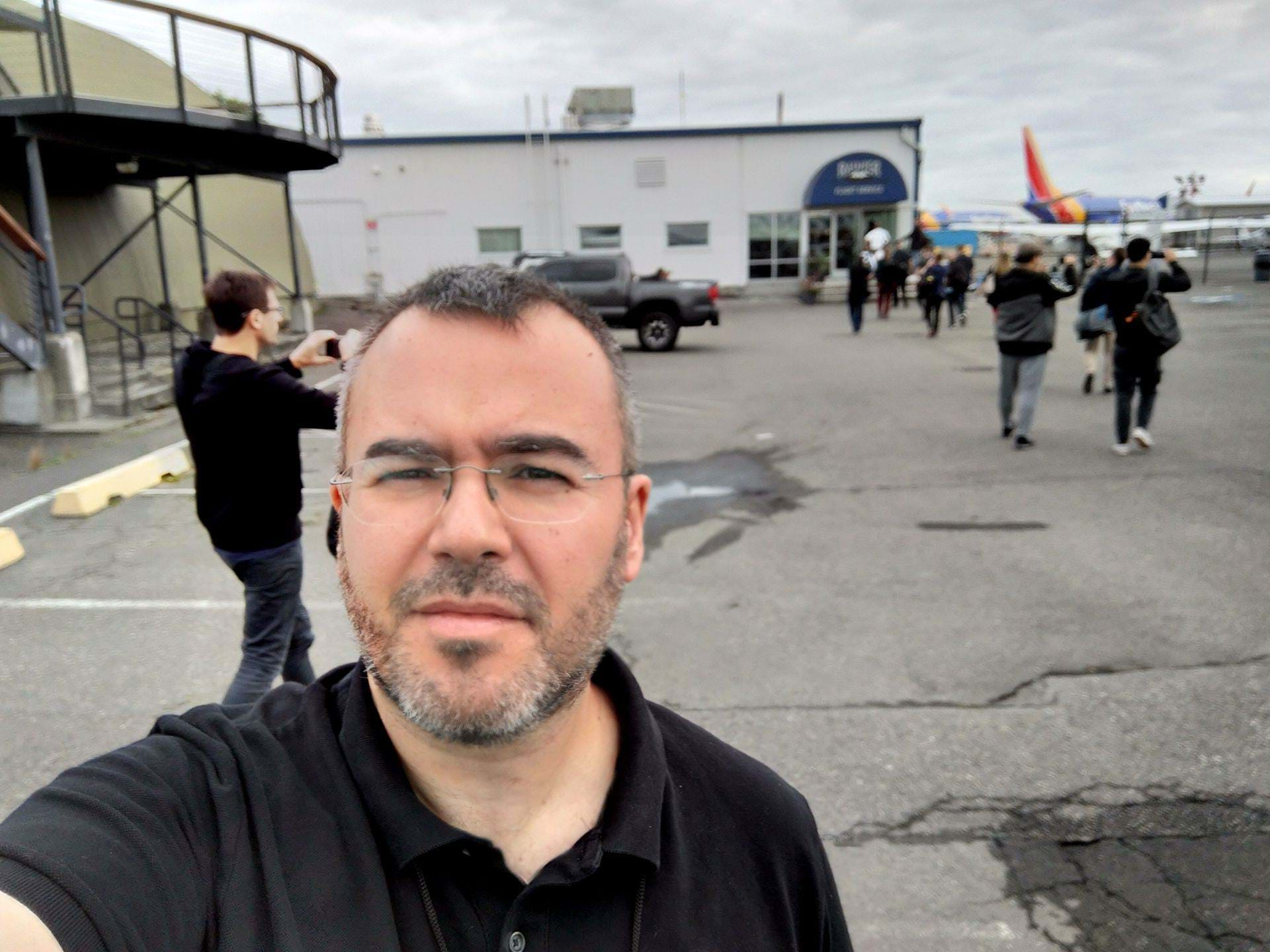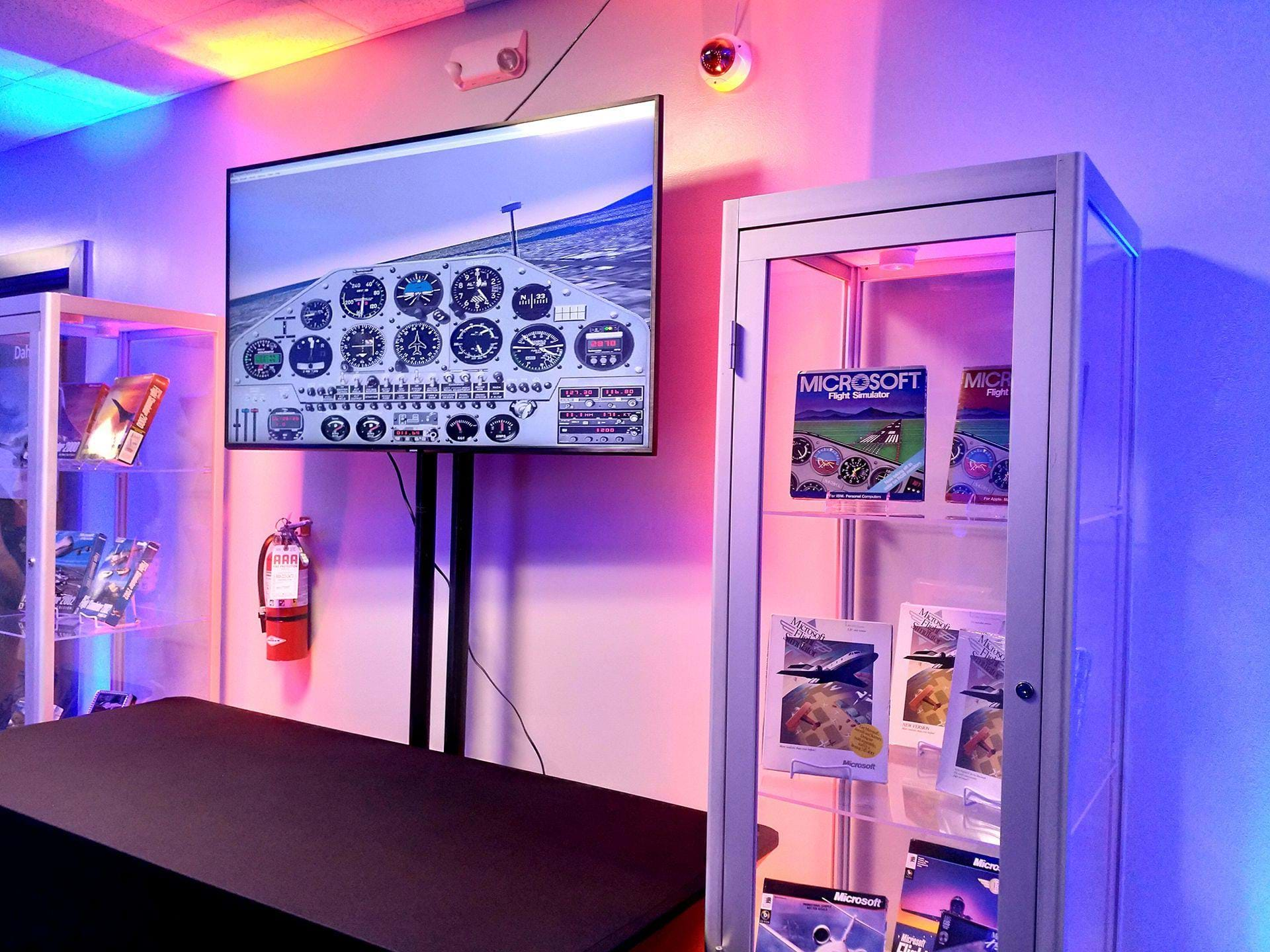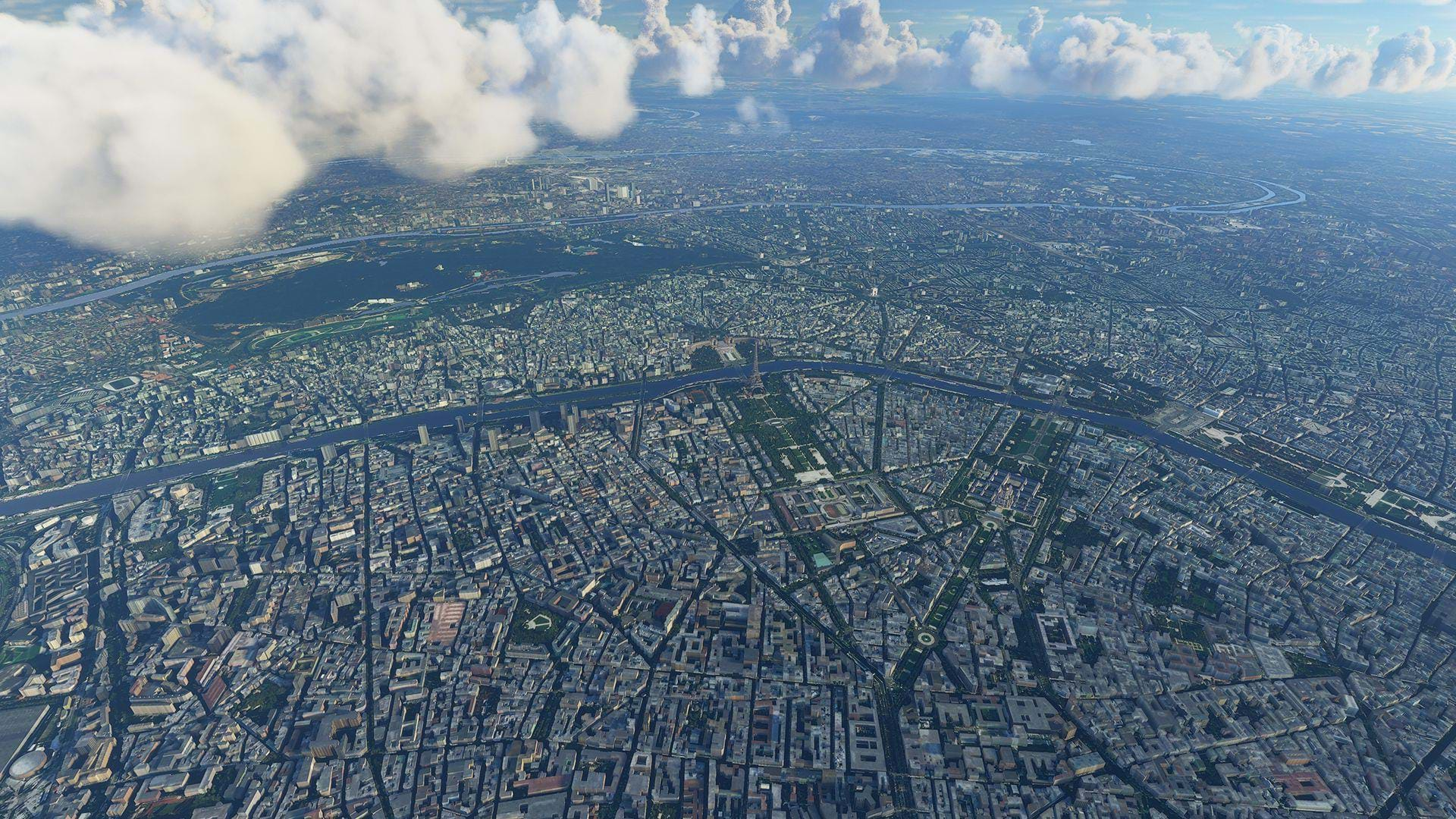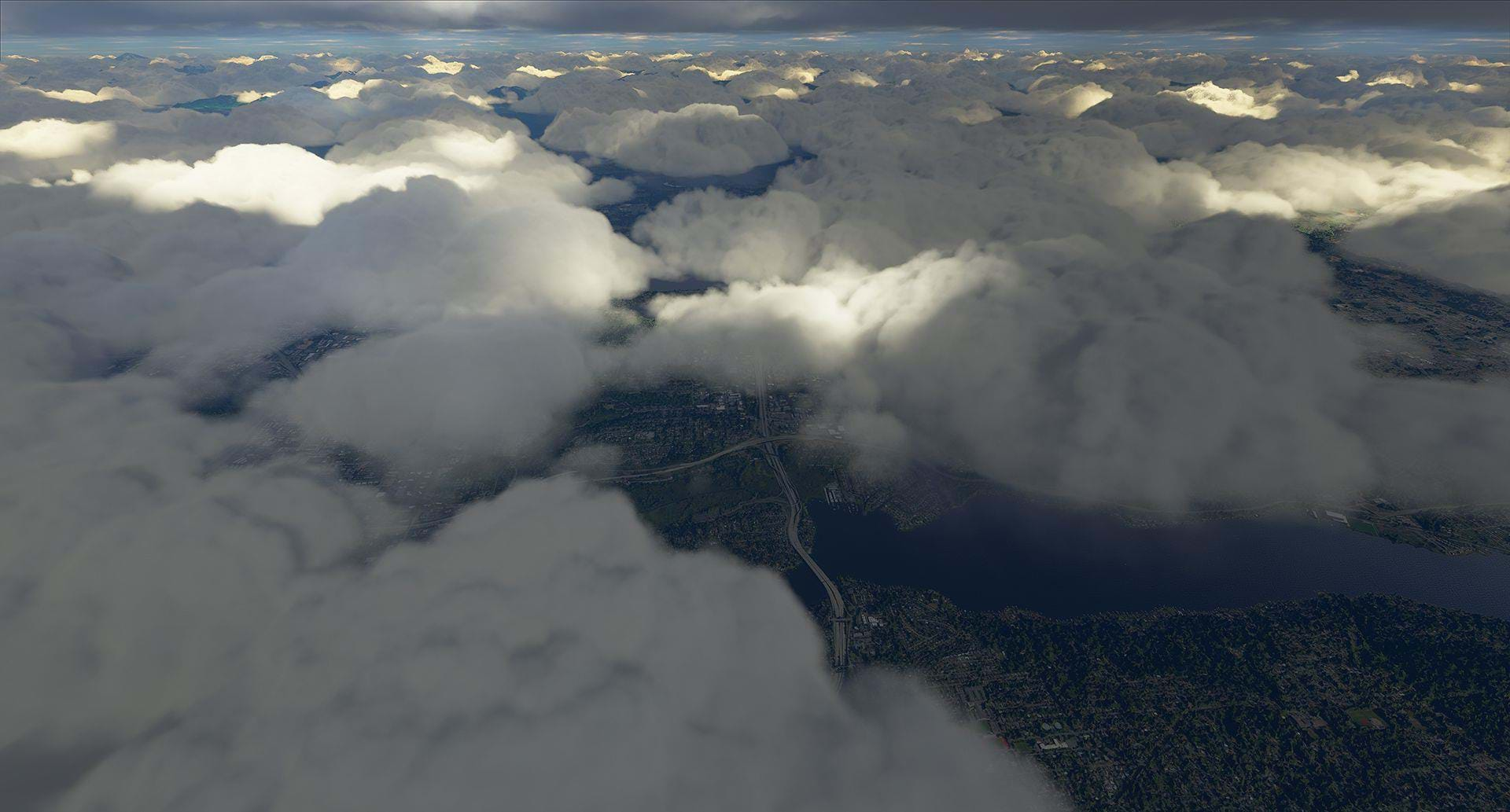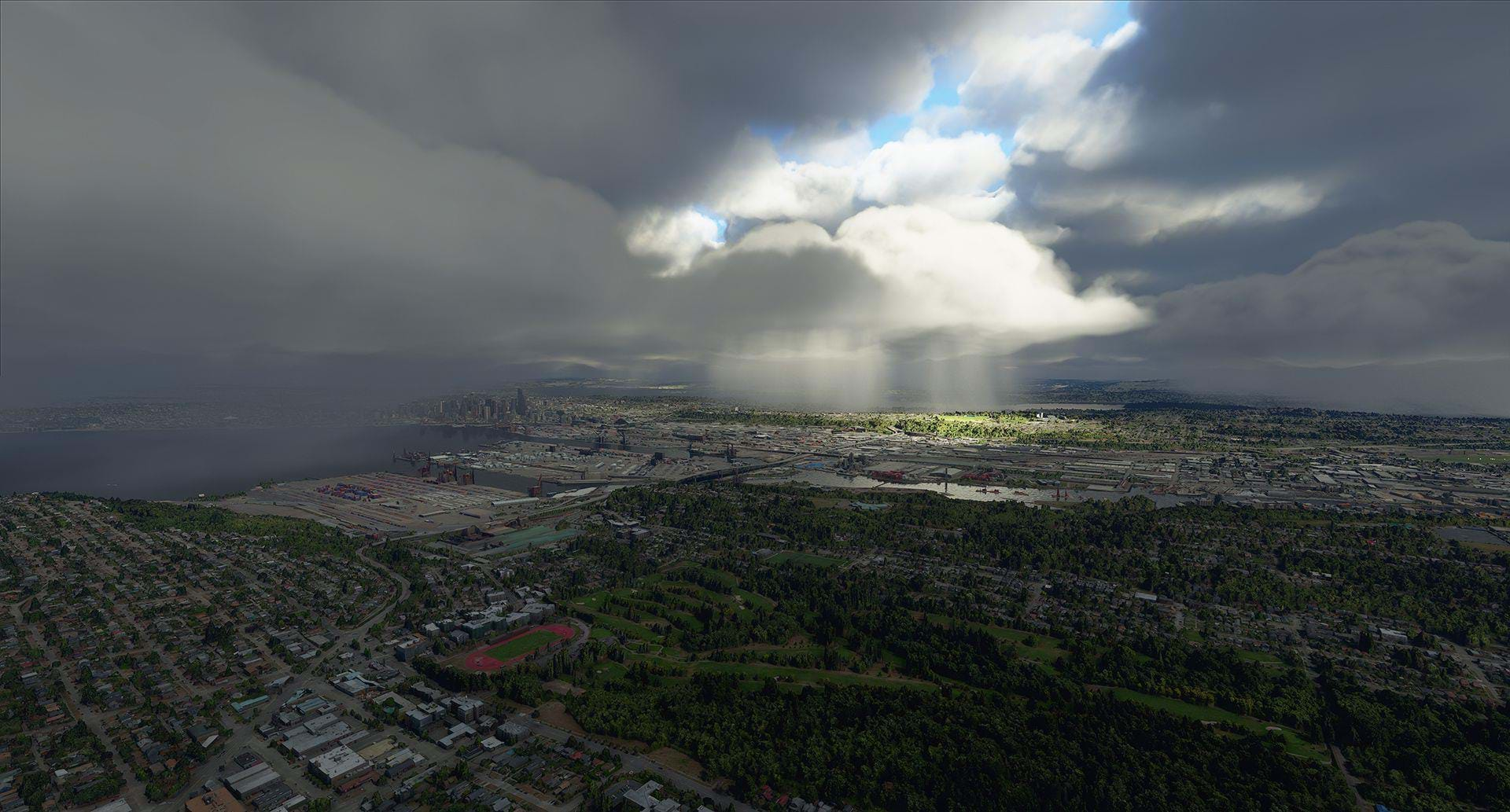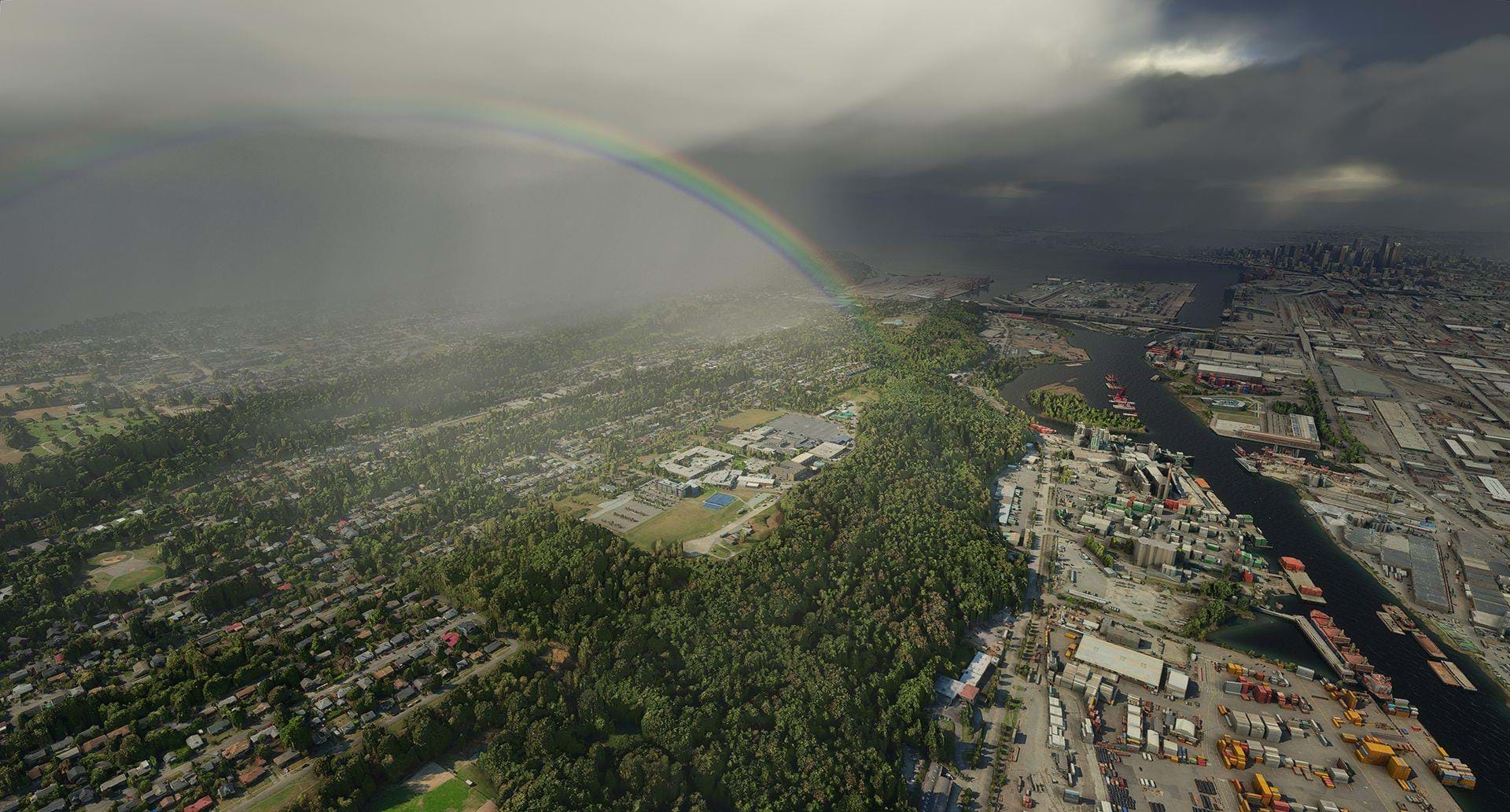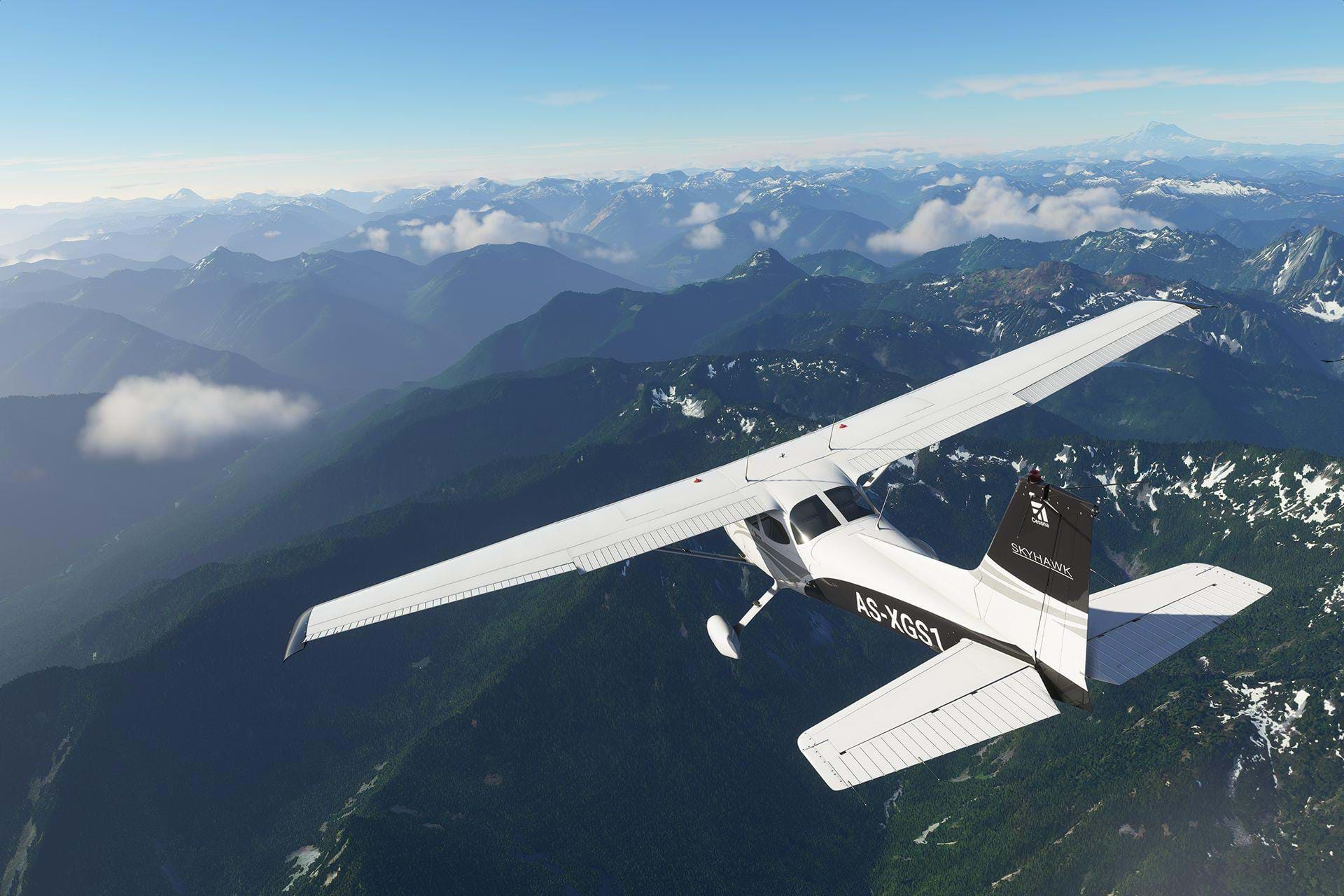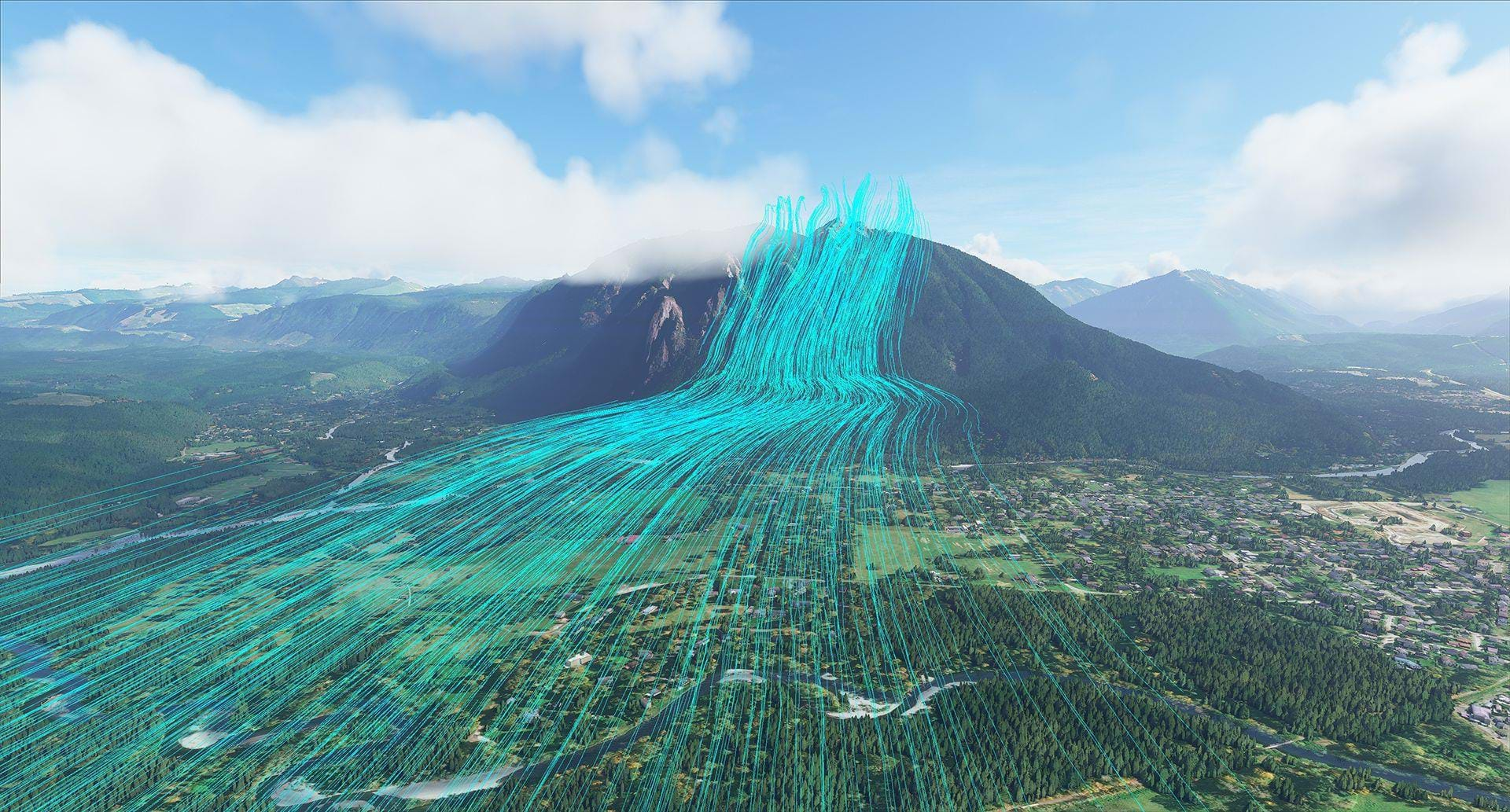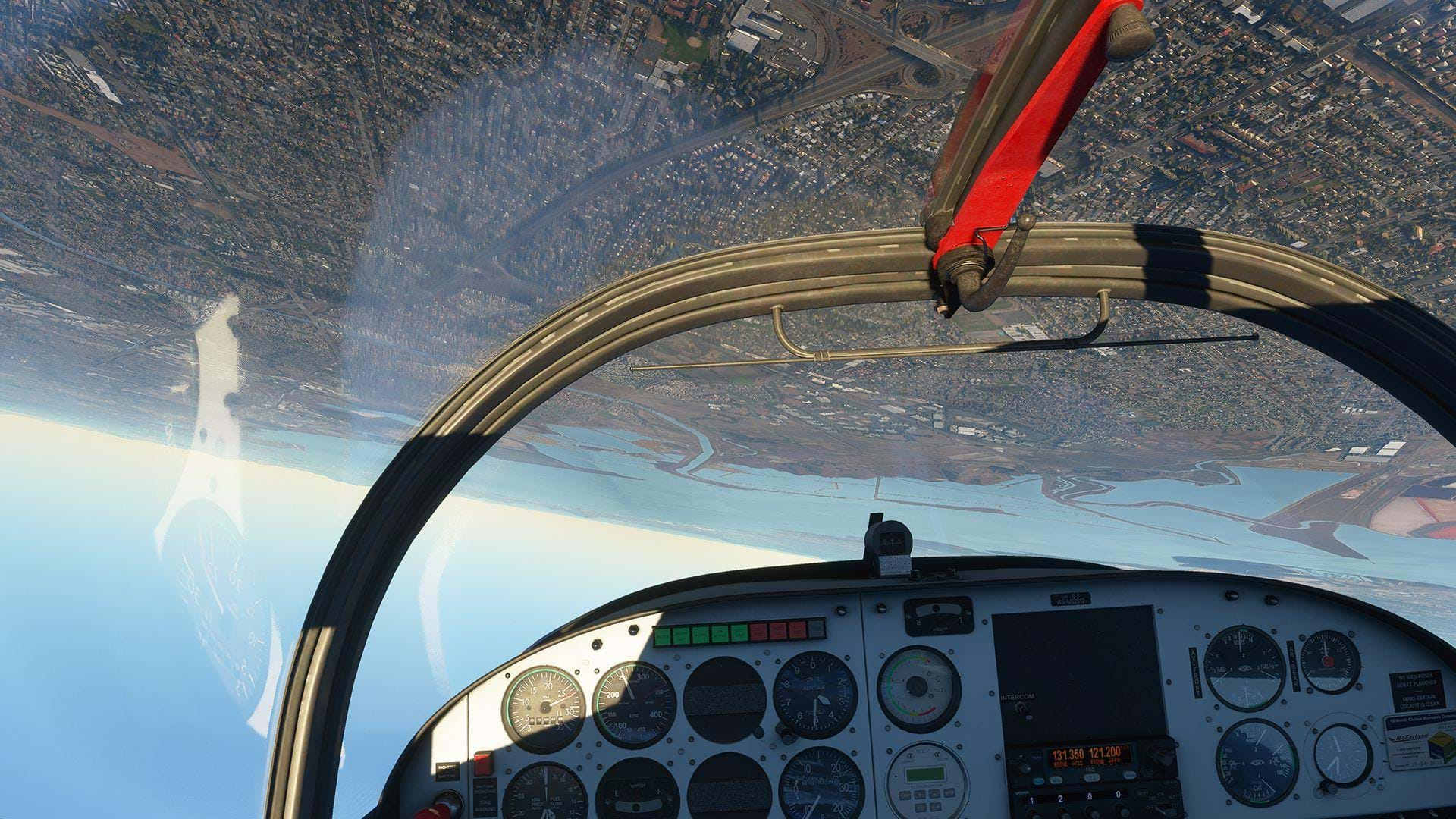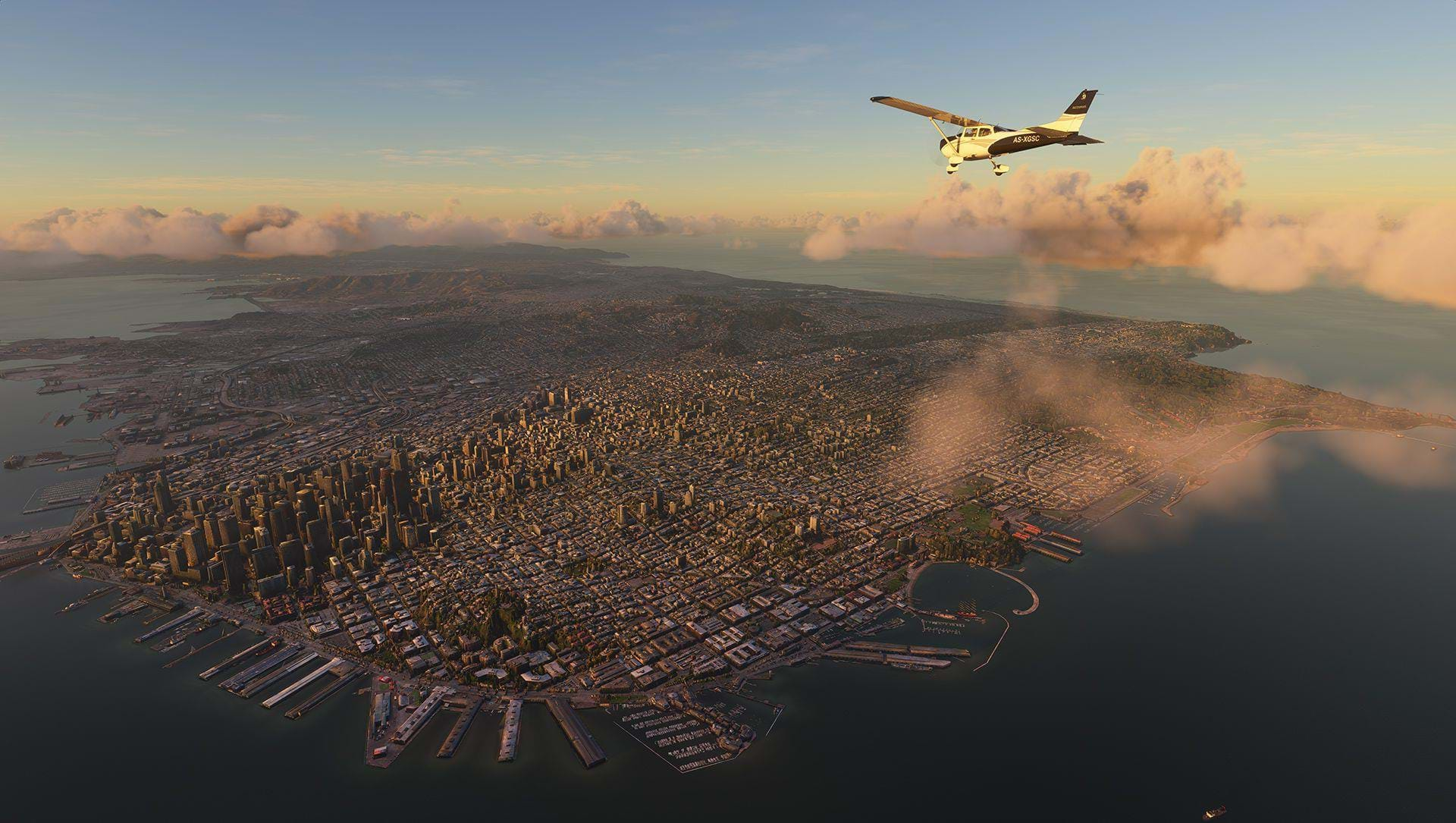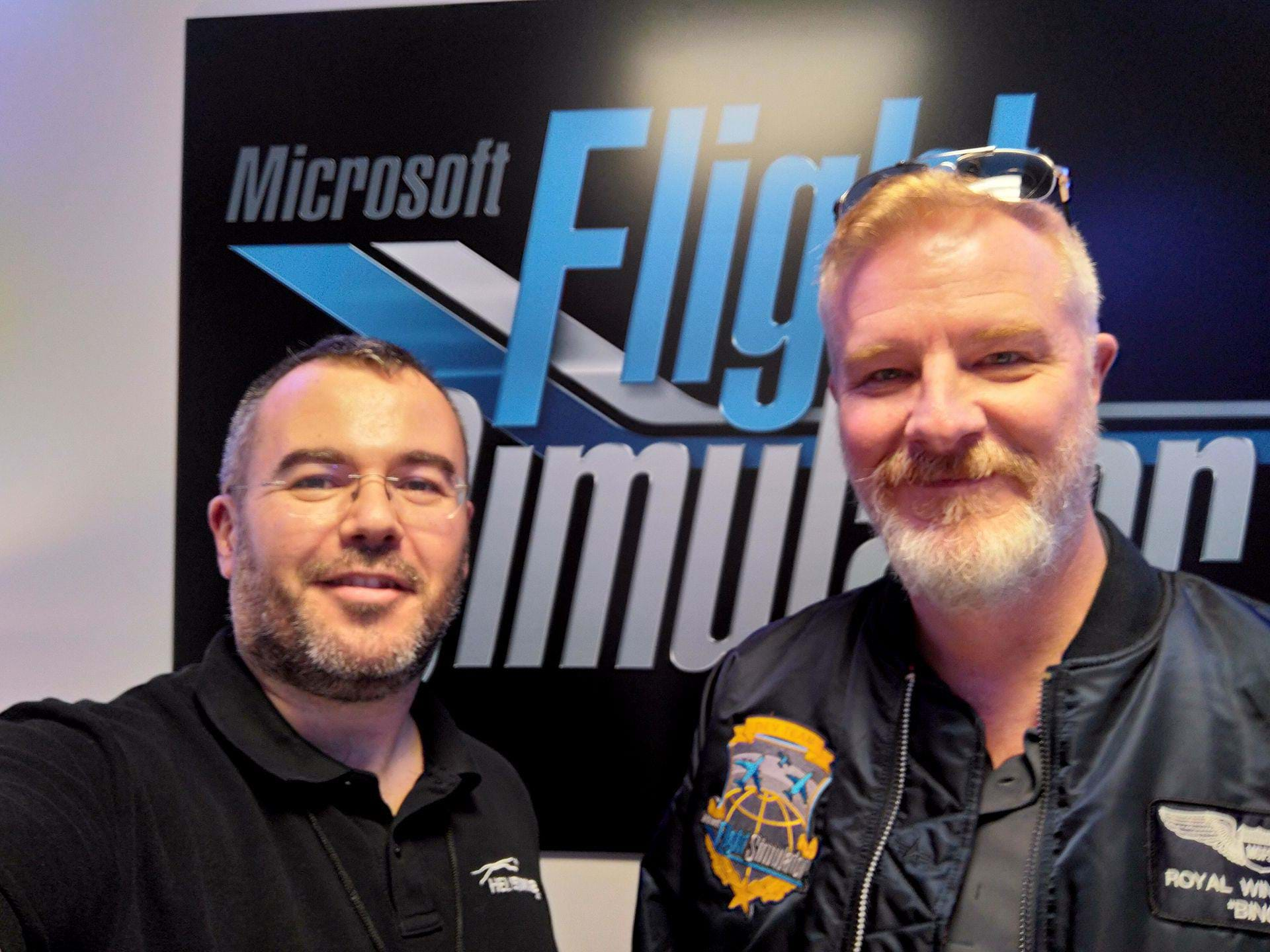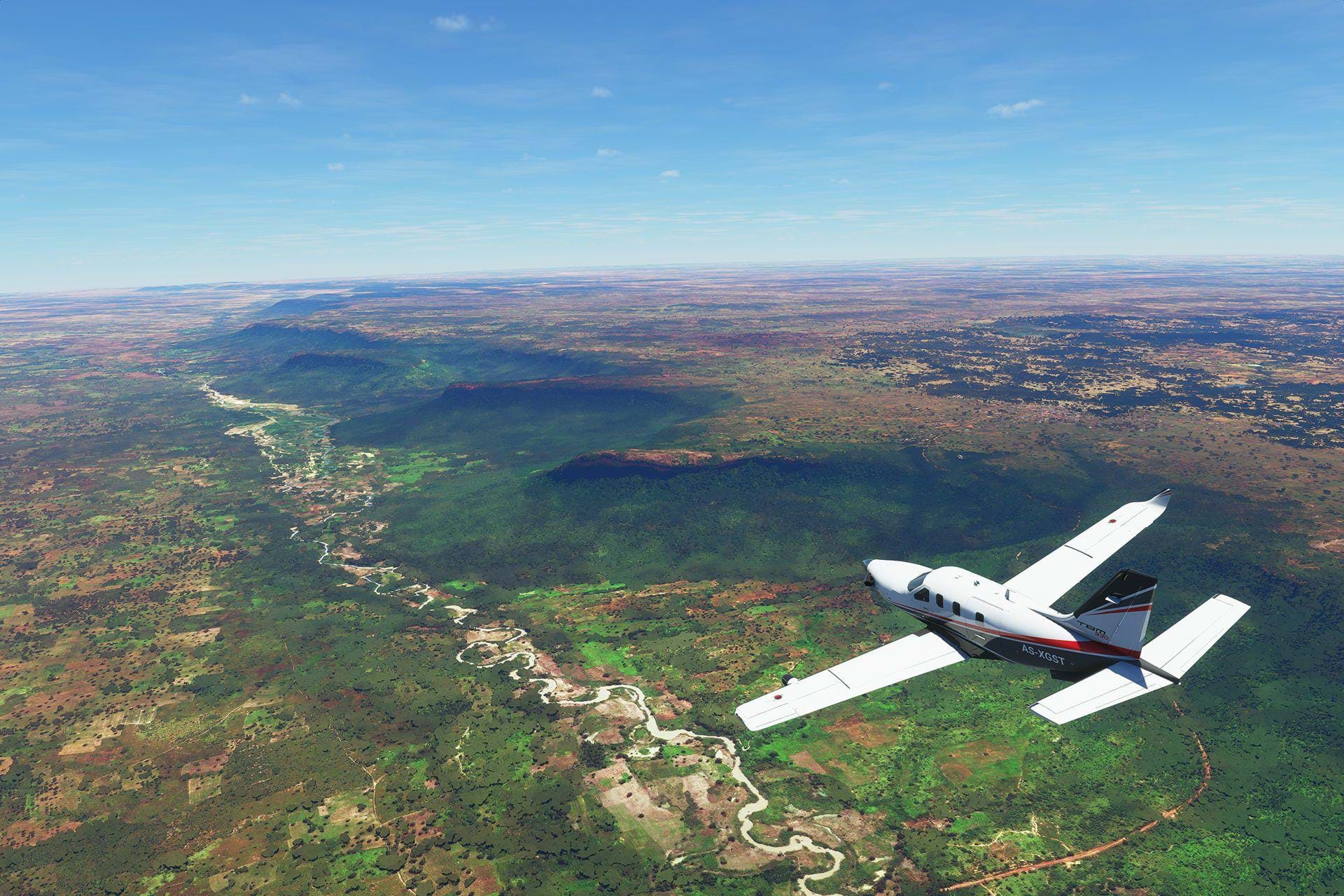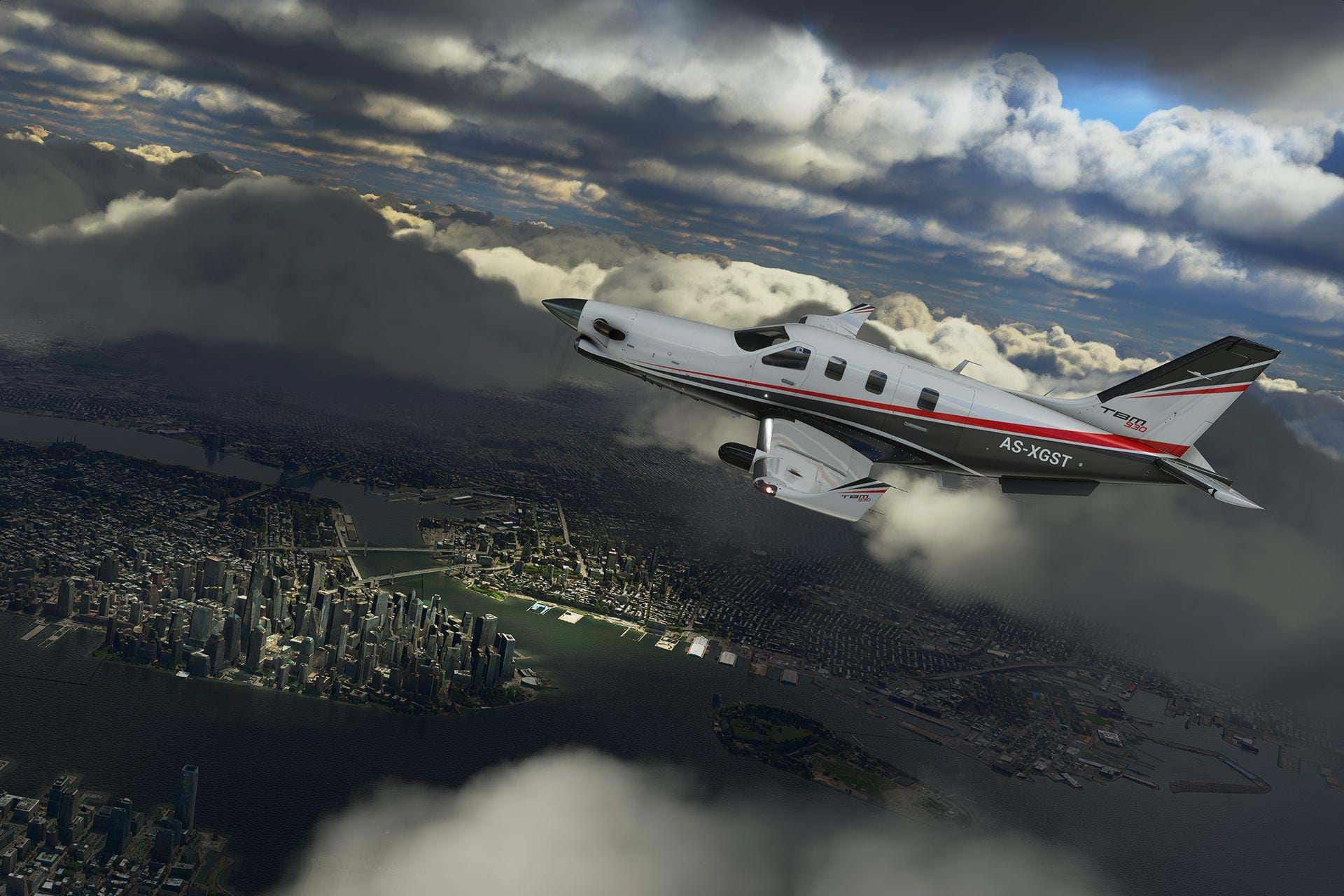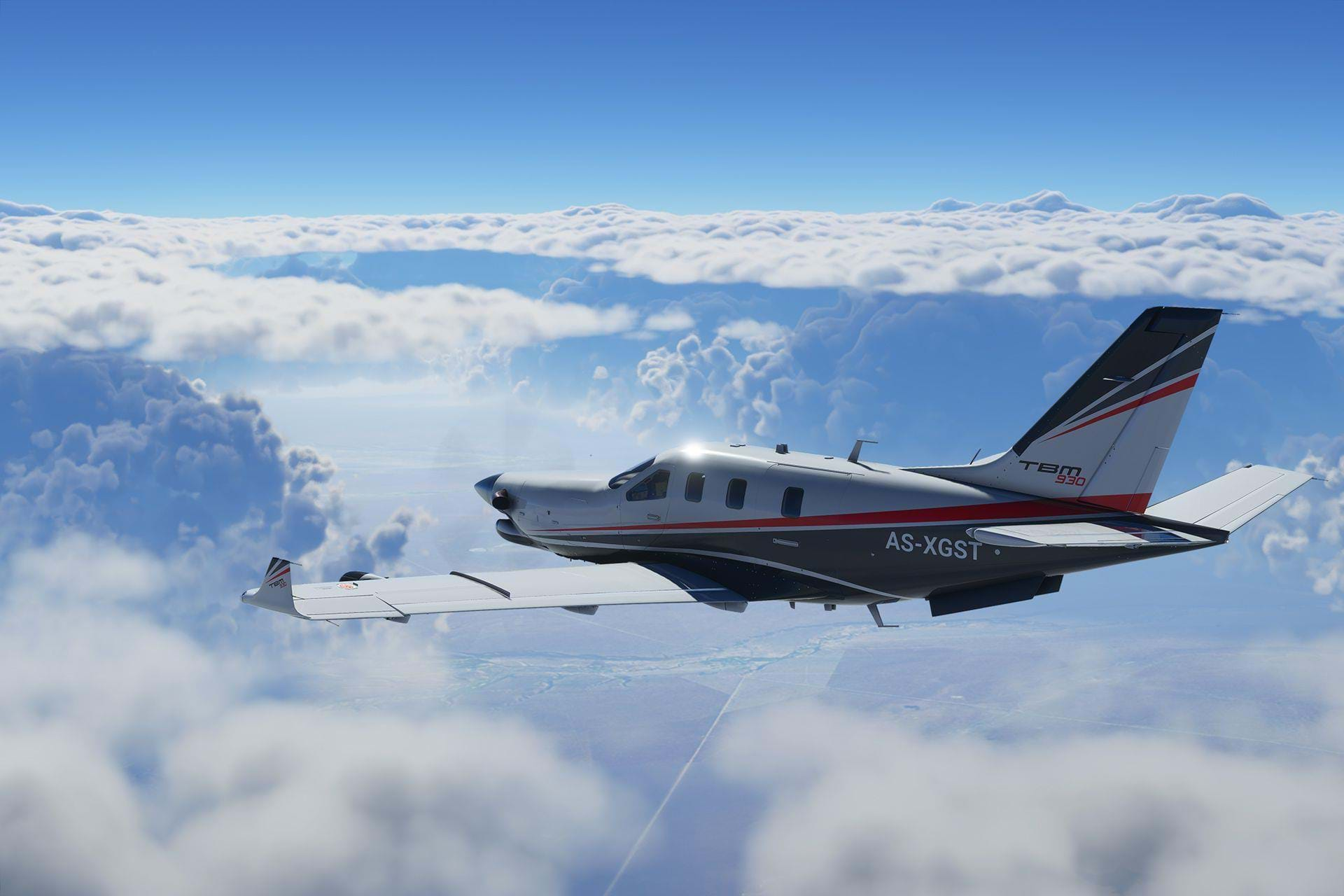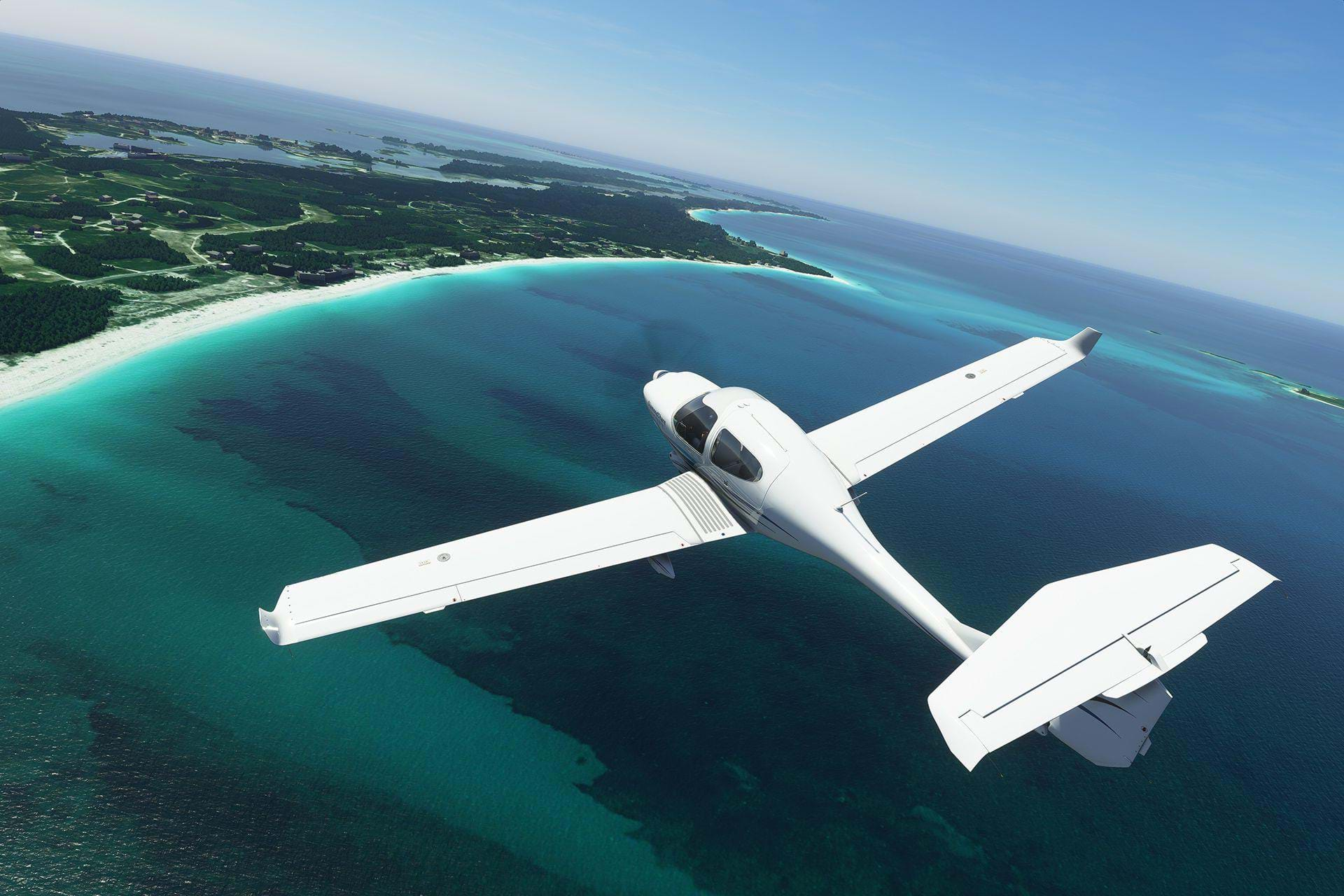Microsoft Flight Simulator – volumetric clouds
The event took place at Rainier Flight Service facilities, located in Renton Municipal Airport and it comprised of a presentation as well as an hands-on session where we had plenty of time to get in touch with the new iteration of the veteran sim.
A small intro
I can hear you already: “WOAH! Wait a minute. Before I read all this. Does it have helicopters?”
That’s why we are here for, right?
I was planning on going through all the cool stuff I am telling you ahead and THEN tell you about helicopters to make sure you went through the whole story and learned the same we did at the event.
But I want to take that out of the way right now and I will make you a deal, though: I will give you the quick, dirty, direct answer to that right away, but you still read the rest of the article. Why? Because, as a simmer, you HAVE to. You owe it to yourself, as a simmer, even if you are not a Microsoft fan.
Please do read what I have to say because I would love for you to understand what’s behind the sim, behind the team, behind the development. What me and the other guys experienced there, how we felt and what we expect from this sim.
You can make up your mind later on. Deal?
So, here it goes: does it have helicopters? No. Not right now.
Microsoft Flight Simulation will, more than likely, not ship with helicopters, but the development team is more than aware of the need of having ALL kinds of flying machines and they are very committed to get them to work the right way. Helicopters included.
Everyone I talked to made that very clear, more than once. In fact, I’ve had team members addressing me personally after the presentation to assure me of that.
What’s the plan, then? Well, they want to get the basics right and move from there as they add more features and complexity to the sim.
Helicopters WILL come in Microsoft Flight Simulator and Microsoft / the development team (you’ll see what I split both further later on this article) wants to make them properly.
In such a way that I was told they would be contacting me so that we, the helicopter flight simulation community, could help them do it. That right there put a huge smile on my face. My main goal was achieved: Microsoft knows who we are, and they will reach out to our community when they need us. That was their promise.
Now to do everything else.
Wait a second. Before moving on, is this article a PR hype maneuver?
Negative. It is not.
Actually, let me put this out there right now. This is no secret for some friends that I talked to before the event (fellow simmers) and definitely not to the development team either to whom I told this directly during the event.
When I was invited to attend the Global Preview Event, I obviously accepted but I was 100% convinced I would be disappointed. The lack of information, all that happened with Microsoft Flight, the selling of the FSX license to Dovetail Games, then DTG stopping development, it all seemed like a huge build up to an even huger implosion and devastating frustration.
Then the surprise announcement at E3 the exact same day Flight Sim Expo ended! All this made me very uncomfortable with the project.
No matter how many times Microsoft have said they wanted to listen the community, it seems the evidences pointed otherwise.
So, yes, of course, I had to be present. But I was all set to get back home very, very disappointed.
Was I wrong? I was. Dead wrong.
So, no, no PR stunts here. Do you sense enthusiasm on my writing? Does everything I am putting here sound too good to be true? Perhaps it does, but everything you’ll read here is 100% true, 100% genuine and real.
My feelings included.
I feel like I have to say this because, honestly, I may sound a bit too overhyped and forcing it a bit.
But the truth is: Microsoft blew my mind.
Is this FSX? Microsoft Flight? Or is it FSW?
None.
Microsoft Flight Simulator 2020 sits on top of a new, proprietary graphics engine. It does have a few parts of the FSX core, some of them which were improved, reworked or even redone.
Not because the development team was lazy but because what they had was already very well done and, back in the good old days, Aces Studios had already solved a huge amount of issues and surpassed nasty challenges.
All that code was working perfectly and so the team decided to use it.
Don’t see it as using “legacy code”, though. As some of you know, I am a developer myself (not a game developer, but still a coder) and I do that very often.
If I have modules or pieces of code that work, I will use it. If I see a way to improve it, I will. If there’s no need, I won’t. And that has saved me tons and tons of time while keeping my code functioning well.
That’s what Microsoft did.
So, again, no, this is not FSX. No, this is not FSW. This is something new.
Why now?
This is a question that has been in the minds of a lot of you out there. It has been in my mind as well. Some theories pointed out that it could be because FSW was cancelled. Microsoft gave us another, completely different reason.
The company sees this as a great time to bring the franchise to live because they feel like the technology, the tools and the partnerships they can form right now make it all possible. With the conjunction of access to Microsoft Azure, available data and third-party companies that have expanded the last few years to become potential partners, Microsoft sees this as the correct timing to enter this endeavor.
The Studio behind Microsoft Flight Simulator 2020
I split Microsoft from the development team a few paragraphs ago and for a good reason.
Just like Aces Studio was the development team behind Microsoft Flight Simulator years ago, Microsoft also has a separate team working on the project. Asobo Studio, a French development company with an amazing track-record with and highly regarded by Microsoft, has a proprietary engine that “can work on gigantic worlds”. Just like Earth.
Asobo accepted the challenge and a few members of their team started having flying lessons and became pilots so that they would understand flight in order to make it more authentic in the sim.
The presentation
During the presentation, we had some Microsoft representants and a few key-developers from Asobo, which was quite a pleasant surprise as we weren’t counting on actually having access to the folks that are actively developing the product.
Left: let's get into the bus
Middle: mmmm... I know that hat from somewhere
Right: Who knows that fella?
We were told a bit about the story behind how work of the sim began. How it was a mix of a small demo with Microsoft’s Hololens where the user could visit extremely detailed locations and the fact that Asobo was doing some tests with their graphics engine, to represent the whole world.
And then they decided to add an aircraft to it. Good idea!
Left: passing next to the Boeing factory
Middle: we're here!
Right: the history of MSFS
The presentation was then split into 4 major areas, where the main responsible for each one talked about their progress and what we should expect.
An important note: we were not allowed to take any video or photograph captures.
The world
This was where the new venture started for Microsoft: the will to make a better representation of the world. It’s something that’s always been a big wish for us simmers and Microsoft is doing just that: the entire world.
With the technology and resources made available to them, Microsoft feels like they can do a good job now.
With Microsoft Bing, the team has access to geographic data, roads, forests and textures. Not only satellite photos but also aerial ones, taken at lower altitudes, from aircraft, with resolutions up to 30cm / pixel.
Microsoft Flight Simulator – New York
But having high resolution textures is only the beginning. Photos are taken on different times of the day and different seasons. So, the colors and lighting change. Shadows change because of the angle of the sun. And clouds kind of enjoy flying around and do some photobombing.
Improving all these textures is a painstaking task which takes dozens, hundreds of hours of work only to do small portions of a small country. Let along the entire world!
This is partially where Microsoft Azure enters. The development team confirmed they are using Windows Azure AI to work the textures, remove shadows, clouds, color-process the textures, understand the color and type of building roofs, placement of trees (1.5 trillion of them) and do all the required work, automatically, to make them look good.
Microsoft Flight Simulator – Paris
This puts a huge smile on my face as it was something I suspected already and mentioned in one of the episodes of the Three Grumpy Simmers where we discussed what we knew (or what we DIDN’T know) about the new sim.
Azure will also be used to store and distribute this data and the textures to users. Out of curiosity, Microsoft mentioned being using “only” 2 petabytes from all the data available at Bing. That’s 2 MILLION gigabytes!
But what does this translate to, exactly. Well, it translates to some impressive numbers:
- 2,000,000 cities
- 40,000 airports
- All the streets of the world
- All the mountains of the world
Basically, you can have the whole world emulated. In fact, Asobo says that “you can now fly VFR everywhere”.
Everywhere.
Out of the box.
Three modes: online, offline and hybrid
This online “streaming” of data is something that has been worrying future users.
“Do we need to be online the whole time?”
“My internet connection is very slow! I won’t be able to enjoy the sim!!!”
These are just a couple of examples of how worry folks are about this streaming thing. And rightly so.
Microsoft told us there will be three levels of detail / bandwidth use:
Online
This is where everything will be amazing and perfect, with the highest quality possible, if your bandwidth allows you.
If it doesn’t, “adaptive streaming” kicks in where the sim verifies your bandwidth and will display the scenery the best way possible, considering your limitations.
Offline
Yes, you can go offline, completely offline and not download anything. The sim will still have great quality (trust me, if it’s as good as the screenshots we’ve seen, offline mode will be miles ahead of a lot of sims out there, filled with addons!).
So, if you don’t have internet connection, you will still be able to have a great quality scenery with a high level of quality and accuracy.
Hybrid
You can also cache parts of the scenery, downloading it as you go online and then use the cached data and files, even if offline.
This allows you to, for example, download the high-quality imagery and data for a region you want to fly at, during the night, and use it the day after, completely offline or not.
Between these 3 modes, you will certainly find a way to use the sim. Even with little to no bandwidth.
Grass, sea and waves
A couple of things that have always been a major problem in FSX (and other sims as well) is grass and water.
These are very dynamic elements that bend to the will of the wind but always required a high amount of processing and are usually the culprit for lower framerates.
Microsoft Flight Simulator 2020 promises to not only have millions of pieces of geometric grass (3D grass) but the sea will also have waves, created by the wind. I had the chance to see it in action on the hands-on as I passed by a river. It was very nice to watch.
The sky
Microsoft Flight Simulator – volumetric clouds
Lighting, atmospheric effects and weather. These were the main areas covered and Microsoft went through all of them, displaying some amazing screenshots of beautiful rendered lighting throughout the different times of the day.
Microsoft Flight Simulator – rain
Rain is now three-dimensional, and you can actually watch it drop, darkening the sky. This means that you can have the visual perception of where the rain is dropping harder or lighter. Which you will be able to proof it as you fly through it and it hits your windshield. Oh, and the sound as it hit the fuselage and glass? It felt like winter.
And rainbows! I kid you not. Under the right conditions, you get to see them form on the sky. I did not get to see one as I tried the sim, but the team has shown some screenshots and talked about it very proudly.
All this is working over an amazingly complex weather system and simulates temperatures, pressures, humidity and a plethora of other factors to present you, in a visually stunning way, a very believable sky and weather.
I would have as well!
Microsoft Flight Simulator - rainbows
Aerodynamics
This was the main part of the presentation for me. The one that I was really curious about and eager to get some more information.
Yes, the visual part is very important, obviously, but it’s pretty worthless if the flight model is bad.
I was very concerned as FSX has quite a subpar flight dynamics and aerodynamics when compared to more modern sims. It would make perfectly sense that Microsoft would want MSFS2020 to be backwards-compatible (something we still don’t know right now) and that could mean we’d be stuck with the legacy dynamics.
But Asobo eased my mind as they started talking about it.
They are using a whole new flight dynamics system, based on calculations performed on the surface of the aircraft.
The old flight model treated aircraft as a unit. Imagine having a single point where the forces were calculated. So, it wouldn’t mind of something was affecting the right wing, for example. Or the vertical stab. Only this one point would be affected. Something happened, and there were lookup tables that defined how the aircraft would behave.
Right now, there are thousands of points or small surfaces on the aircraft in which the forces are calculated and everything is simulated and calculated across them: pressures, forces, everything is realistically calculated hundreds of times per second on the thousands of sub-surfaces and the aircraft reacts accordingly.
Microsoft Flight Simulator
These sub-surfaces can also influence other sub-surfaces. The air crossing a certain part of the aircraft can be affected by it and the way it interacts with the next surface. Because of this, icing is now possible and realistically simulated as well.
Because of all this, the team even mentioned aircraft are not “on rails” anymore, an expression wildly used by the community to demonstrate how predictable and closed the FSX flight model is. A clear demonstration that they understand our frustration and that they want us to know they fixed it.
Something that Asobo also told us is that if users want to use the old flight model, it’s there. The legacy flight dynamics are present, and you can select to use them or not.
But hey... You can now stall a single wing! Why would you want to go back???
Another thing that left me really excited was how modeling of the air is being done. The team has shown us how air flows not only around aircraft but also the scenery.
You will get jet streams, turbulence, airflows, thermals, pressure differences, all influencing your aircraft. And not influencing it as a single point either.
Microsoft Flight Simulator – wind over mountains
Before finishing this section, I want to add something. This is not blade element theory. We are not talking about the same system X-Plane uses. Asobo is using a different system which should render similar results, though.
The fact that things are not “set in stone” anymore and the sim doesn’t go read a table, with constant data that gives you that “on rails” feeling.
Everything is much, much more dynamic now.
Frames have less impact on the physics
Physics calculations are not attached to framerates anymore. Usually, you’d need 30 FPS (frames per second) to be able to have a decent amount of physics calculations. Microsoft Flight Simulator 2020 separates physics calculations from the framerates.
This means that you can have less than 30 FPS, but the flight dynamics are still working properly.
Cockpits
Microsoft Flight Simulator – cockpit CAP 10
The last big theme the team wanted to talk about was cockpits. The team went on to talk a bit about systems and cockpit lighting as well as a new rendering engine for 2D and 3D, which can be used on glass cockpits.
Interactive checklists
Another cool thing we were shown was the interactive checklists (something that Dovetail Games had done for their FSW) where you can have the instruments and switches pointed out or you have the aircraft starting up on its own, just like the previous versions.
Data I/O
They also talked about the input and output of data, for home-built cockpit (and other uses), through something like a new version of SimConnect, with access to a lot more variables.
Third-party developers
Without going into any details, Microsoft indicated they are already in contact with third-party developers, which they realize are a big reason of all the advances and even the survivability of Microsoft Flight Simulator throughout the years.
As such, Microsoft is embracing and “already talking with just about all of them”.
I wouldn’t be surprised to see a few products coming out as soon as MSFS2020 comes out or very early after the release. Microsoft has quite a great ecosystem and access to hundreds of developers eager to expand their market. Getting them in from day one not only reinforces the presence of the new sim but it also helps Microsoft convince users by showing them things are rolling fast.
The community
Microsoft also addressed the fans and the community. The company is watching closely. They are monitoring forums, magazines, articles and everything else that provides them with information of what the community wants, what are our needs and hopes, where we all come from and what we all want to reach.
So far, Microsoft has been very slowly releasing information. Despite some videos and screenshots, there was not a lot out there until the day this article, along with dozens of other ones and videos, I’m sure, goes out.
This was done intentionally. Microsoft wanted the Global Preview Event and today – the day all this info comes out – to be the days for the community.
They wanted us, media and “simfluencers” (sorry Edson, I had to steal this one from you) to have the whole impact of every single little thing they gave us at the event.
And it worked. I think I speak for a lot of us there when I say we were mind-blown. We got to know pretty much everything we wanted and now we get to tell you all what we saw and experienced.
I was a very loud voice in the community regarding the lack of information. But now I get it and I am grateful that Microsoft did it this way. The community gets to be the vehicle of information for the community and you guys get to contact those that are close to you, your favorite bloggers, YouTubers, writers and everyone else that was at the event and ask them about it.
I love it.
The hands-on
Now for the juicy part.
After the presentation, we were led to an adjacent room where there were a few booths all set for us to sit down and try Microsoft Flight Simulator for the first time.
Listening to the good old menu music, we were presented with a very nice, modern and clean user interface. Great first impressions.
Microsoft had set up the default airport to be the same we were at (Renton Municipal Airport) but, honestly, I was more interested in throwing Microsoft and Asobo a curved ball.
And so, I started a flight at Portugal. Cascais, to be more precise (LPCS) as I wanted to fly around that area and Lisbon as well.
Considering how bad flight sims usually treat Portugal that was a nice test. One that Microsoft passed. Not exactly with flying colors as some landmarks are missing (namely the huge red, Golden-Gate-twin bridge in Lisbon) but hey… It’s passable. I am sure someone will add that as well as other important buildings.
But overall? I was VERY impressed.
Flying around the area felt fluid, live. I changed the weather and every change was immediate with stunning results. We had both themes and real weather available. I couldn’t find how to customize weather, but I guess it’s wasn’t available at all.
Microsoft Flight Simulator
The sky looks beautiful. Clouds are amazing and they cast shadows on the ground and on each other. The color of the sky is beautiful and the lighting amazing. And with each change you’d get different wind, pressure, temperature and aircraft behavior.
The rain is just absolutely stunning. Idling the engine allowed me to pay better attention to how the raindrops were audible on the fuselage.
Flying in Microsoft Flight Simulator is so much challenging than flying it its older counterpart. Granted, there are no helicopters yet (I feel like I need to address that again) so I had to fly around on a fixed wing.
But I tell you: it was the most fun I had with fixed wing aircraft in a long time. The sense of discovery, the new amazing scenery, the way the sky is rendered, and the physics and flight dynamics make it all just… Come to live. No more rails.
As I did some more flying, I had to do the ultimate testing. I tried the Azores. Mainland Portugal is usually very poorly treated but the Azores? Those islands are thrashed around by pretty much every single sim. The Azores is a beautiful place to visit and fly at but there’s no good rendition of it.
Not anymore.
Granted, it’s not perfect but the islands are there. I took off from Horta (LPHR) and turned to the Pico island and there is was. The huge mountain (the tallest one in the country) majestically rising itself from the bottom of the ocean to touch the skies and the clouds around it. Well not around it. The clouds seemed to be coming from the right and climbing to the top. There were clouds on the left as well but at a higher altitude as if they climbed and continued their path a few hundred feet higher.
I lost myself in the sim. All the options are fairly accessible although I feel like some UI tweaks may be needed – I provided that feedback to the developers and QA folks present which took notes of everything we said – but, other than that, it’s very well built.
In fact, considering it’s an Alpha… It’s freaking damn impressive. It didn’t feel like an alpha at all. Except the couple of times I crashed the sim. One of them so that they had to replace my computer.
Yeah, the helicopter guy broke the Cessna!
The face-to-face with developers
What I cherish most of the whole thing, though, is the face time we had with developers. Unfortunately, because of some minor organization hiccups I didn’t get to interview anyone, but I have spent so much time talking to everyone in the development team that I don’t care!
I spoke with everyone there and I was able to congratulate them, as I looked in their eyes, for the hard work and what they have done with the sim.
A lot of them (if not all) were aware of what everyone in that room did and they knew what I was looking for personally: helicopters. Some of them addressed it by themselves and told me that they know they have to get helicopters in the sim, but they want to “do it properly”. I heard that expression so many times that day.
Everyone. Every. Single. One. Everyone seemed passionate, interested in listening to us, eager to show their work. We were all one in that room. It wasn’t “we” and “them”. I didn’t feel that at all. I felt that we were together, united for a common goal: the love and passion for flight. For the sim.
Meeting a legend: Aces Studios’ Royal Winchester
Me and Royal Winchester
I have to say that I got a bit start struck. This guy gets in the room, nods at me, shakes my hand and presents himself. I was mind-blown when he mentioned that he was Royal Winchester, former Aces Studios member.
I had an Aces Studios guy right in front of me. Legend!
First thing I did? I thank him. I thank him for all the work the Aces Studios had throughout the years of work with Microsoft Flight Simulator. It’s not everyday you get to do that. And I had to. Aces Studios gave me so much and I have never had the chance to thank them. Until now.
Mr. Winchester then asked me what I thought, and I told him that I was very, very pleased with the presentation as the team had covered pretty much everything I wanted to hear about.
“Not everything”, he said. “You didn’t hear about something you want to hear about. Which is right there on your chest”, he continued as he pointed to the HeliSimmer.com logo on my shirt.
“Oh yeah”, I replied, “but when I heard about the aerodynamics and that you want to bring all sorts of flying machines to the sim, that kind of hinted me that they will make an appearance”.
And that was the first time, of many times I heard the expression “we want to do them properly”.
Everything can still go wrong, of course, but right there, and after I spent a few minutes with Mr. Winchester, I felt like “he gets it”. He gets what folks that like GA, helicopters and other types of aircraft need, and hope for in a sim.
And I felt like the team wants to make it happen.
What to expect
So, what to expect of Microsoft Flight Simulator 2020?
I am expecting a lot myself. 600Km of draw distance, a fully rendered world (with still a lot of potential and room for third-party scenery developers), great aerodynamics, amazing weather and quite a good performance even on an alpha.
Microsoft Flight Simulator - 600Km of draw distance
We were running the sim at 4K (for real) with a GTX2080 at very high frame rates without any issues. I wonder if my puny GTX1660 will handle it at HD, but I suspect I won’t have that many issues, especially since there’s room for a lot of optimization.
Expect a mature, modern sim with a lot of great components out of the box but still a great framework for developers to add their own stuff. I foresee the scenery market growing in a different way. I don’t think there will be a lot of cities to be built as the sim will take care of that, but I am guessing developers will focus more on landmarks, airports, helipads and adding small bits of details and life to the sim.
Do we need to pay for a subscription?
A lot of people asked about this on social media and forums and it’s unclear right now. Yes, this was asked but Microsoft was very honest about this.
They would prefer if we didn’t have to but there’s a chance we might, especially since we are using their cloud.
There’s also a chance we might not pay for a subscription. So, don’t go around, guns blazing saying “Sérgio said there’s a chance we might pay”. Because it’s unknown right now. Not even Microsoft or Asobo knows that yet.
We’ll have to wait and see.
What about Virtual Reality (VR)?
We had to ask about VR, obviously and what we were told was that it's on the roadmap. It's not present right now -- and we honestly don't know if it will be on the first builds, or even on the final release -- but the team knows the importance of VR and they will include it.
Hopefully, sooner than later.
Playing with friends
Multiplayer was also addressed during the Q&A. The team indicated it is planned but it wasn't exactly clear how it would be implemented and what could be done. I talked to the team about the possibility of sharing cockpits -- which can be used to teach others to fly, for example, and they were very interested about it.
Perhaps we will finally have a way to use a sim as a remote teaching tool?
My final thoughts
I am impressed. Mind-blown. Excited. Much more excited than I ever though possible with this title.
Like I said, I was expecting to return from Seattle disappointed, but I returned with a renewed hope for this sim. After I met the team, I realized how committed they are. I just hope Microsoft keeps on investing on the sim and on these teams as I believe there’s a lot of potential to grow.
There’s so much that can be made, especially with the services and technologies Microsoft has at its disposal.
This event was a brilliant move by Microsoft, and I hope they continue to do it as it certainly brings the community closer to them.
What now?
Well, now you can ask away. I have done my best to present you with all the information we got but I may have forgotten something. Do you have any questions or doubts? Please do so on the comments section below.
Share your thoughts, ask for questions. I will do my very best to answer them. I don’t know everything, of course, but I’ll spill the beans about everything I know that can be addressed publicly.
Meanwhile, if you haven’t done so, head out to the official Microsoft Flight Simulator website, register as an Insider and perhaps you’ll be lucky enough to get into the Alpha program.
You can, of course, also follow Microsoft Flight Simulator on Twitter.
And now the wait starts.
(Sorry for all the fixed-wing screenshots, folks -- that's all we could get from Microsoft! I hope to show you some great helicopters someday.)

